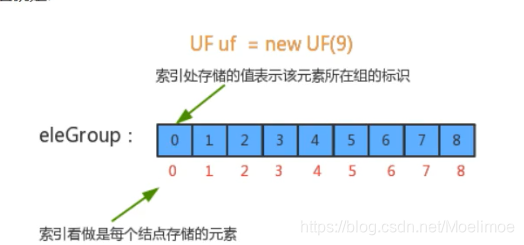并查集的介绍
- 并查集(Union-find)数据结构也称作合并查找集(Merge-find set)或者不相交集数据结构(disjoint-set data structure),它是一种记录了由一个或多个元素组成的不连续的分组的集合。并查集提供常数量的复杂度来添加、合并以及确定两个元素是否属于同一个集合。
- 并查集除了能够实现这些快速便利的操作,它在Krukal算法中寻找最小生成树的图也起着关键的作用

并查集结构
并查集是一种树形数据结构,但是它和二叉树、红黑树、B树不同,它对树形结构的要求十分简单:- 同一个数据组中的元素对应在同一颗树(判断两个元素是否在同一颗树时,可以判断根结点是否相同)
- 同一数据组中的每一个元素对应树中的一个结点
- 不同数据组之间不存在任何相关的联系,可以看做多个数据组成一个森林(合并数据组时,只需要将一棵树的根结点指向另一颗树的根结点即可)
- 树中的结点不存在硬性的顺序/父子关系
并查集的功能实现
方法设计
- self.groups 是一个列表,其索引代表传入的元素的值,其元素代表传入元素所在分组
- count_groups() 返回并查集中组的数量
- which_group(item) 判断传入的元素item属于哪一个群组
- in_the_same_group(item1, item2) 判断传入的两个元素是否在同一个分组
- merge(item1, item2) 将两个元素各自所在的分组合并到一个组,合并后的分组为后者所在的组

Python代码实现
class UnionFind:def __init__(self, n):self.num_groups = nself.groups = [i for i in range(n)] # Let the indices be the elements, and the elements be the group numbersdef count_groups(self):return self.num_groupsdef which_group(self, item):"""The indices are items, the elements are group numbers"""return self.groups[item]def in_the_same_group(self, item1, item2):return self.which_group(item1) == self.which_group(item2)def merge(self, item1, item2):group1 = self.which_group(item1)group2 = self.which_group(item2)if group1 == group2:returnfor i in range(len(self.groups)):if self.groups[i] == group1:self.groups[i] = group2self.num_groups -= 1
代码测试
if __name__ == '__main__':UF = UnionFind(5)print(f"The initial number of groups is {UF.num_groups}")print(f"The initial groups is {UF.groups}")while True:p = int(input(f'Input the to-be-merge element: '))q = int(input(f"Merge to the target element's group: "))if UF.in_the_same_group(p, q):print(f"They are already in the same group")continueUF.merge(p, q)print(f"The number of groups now is {UF.count_groups()}")print(UF.groups)
测试结果
The initial number of groups is 5
The initial groups is [0, 1, 2, 3, 4]
Input the to-be-merge element: 0
Merge to the target element's group: 1
The number of groups now is 4
[1, 1, 2, 3, 4]
Input the to-be-merge element: 1
Merge to the target element's group: 2
The number of groups now is 3
[2, 2, 2, 3, 4]
Input the to-be-merge element: 2
Merge to the target element's group: 3
The number of groups now is 2
[3, 3, 3, 3, 4]
Input the to-be-merge element: 3
Merge to the target element's group: 4
The number of groups now is 1
[4, 4, 4, 4, 4]
Input the to-be-merge element:
最少需要n-1 = 4 次合并,就可以将所有元素都合并到一个分组到一个组。



















 Function3 函数参数二)